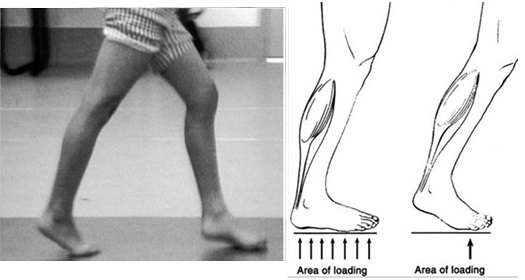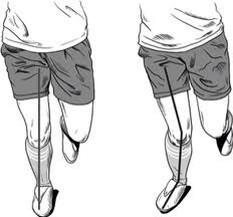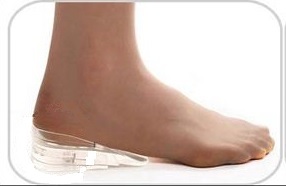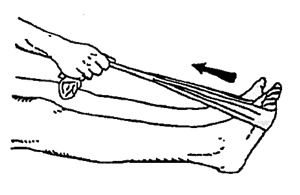A contracture happens whenever a muscle gets stuck in its shortened position- making the joint have less motion than it should. In the case of a Plantarflexion contracture, the joint in question is the ankle. The muscles on the back of your calf are called the Plantarflexors. Here is a picture of those muscles:
The plantarflexor muscles are anchored behind the knee and are responsible for pulling up on the back of the heel, which makes the toes point downwards. This is called a plantarflexed position.
When the muscles in the back of the calf are in contracture, it means that the person is unable to move his or her foot into normal position. (The opposite of plantarflexion is a motion called dorsiflexion, which means bringing your toes up. See the picture below). Dorsiflexion can only happen if the muscles in the back of the calf are able to be stretched.
The yellow line in both pictures represents the “neutral” position of the foot. In order to walk normally, you have to be able to move your foot a few degrees beyond this line. This becomes impossible if the plantarflexor muscles are contracted.
Moderate to severe Plantarflexion contractures occur very frequently in people who have been born with Cerebral Palsy, had a stroke or suffered some sort of injury. More mild versions of a Plantarflexion contracture can happen to anyone. As you can see in the picture above, the mildest form of Plantarflexion contractures just means that you are unable to pull the front of your foot up towards you past the neutral position.
I have found that VERY MANY people who complain of foot pain have a mild case of Plantarflexion contracture. There are two reasons for this high correlation:
- If you have really tight Plantarflexor muscles you probably also have a very tight Plantar fascia. This is because the two are very closely related. See this previous post about the topic of a tight fascia and tight calves. https://walkwellstaywell.wordpress.com/2012/09/05/plantar-fasciitis-a-real-pain-in-the-arch/
- If you have a Plantarflexion contracture you are probably spending a bit more time walking on the front part of your foot since you are already in “tip-toe” position. This means that instead of distributing your body weight over the entire foot, a lot of stress is concentrated at the front your foot (The metatarsal region).
Walking with a Plantarflexion contracture is not only bad for your feet, it can also effect the rest of your body – especially the hips, back and knees.
People with Plantarflexion contractures tend to compensate by moving their knees into bad alignment when walking or standing. This causes stress to the knee joint because if forces the knee to be in an unnatural position. The hamstrings then get sore and tight, they pull on the hip which then puts extra strain on the back. The net effect is to make the person’s feet, legs and back feel sore and tired.
Now when someone with a Plantarflexion contracture comes to me for treatment, I am faced with two options:
I can make them feel better
Or
- I can help them actually get better
In order to make someone with a Plantarflexion contracture feel better, all I have to do is put a wedge underneath their heel inside of their shoe. (Or instruct them to wear a shoe with an elevated heel). This solution essentially brings the floor up to the foot – It makes up for the fact that the person cannot get his or her foot into the neural position. In fact, it encourages the foot to remain in a nice relaxed Plantarflexed position. So what’s the problem with that? Well, it’s fine as long as the person can always have a wedge under their heel. But it means that they will no longer be comfortable walking without their shoes on. They are now dependent on the heel elevation to be able to walk without pain. This position becomes their new “normal”. If maintained long enough, the foot loses its ability to dorsiflex even to the neutral position. The patient has now moved to a more severe level of Plantarflexion contracture.
In order to actually chose option #2 and recover from a Plantarflexion contracture, the patient needs to be encouraged to do just what the foot doesn’t want to do – Dorsiflex. In other words, they need to stretch. Aggressively! The plantarflexor muscles are very tough and strong and they are not going to give up without a fight. Research suggests that if you are stretching to overcome a Plantarflexion contracture, you will need to stretch for at least 30 minutes per day. You can read more about the topic of calf stretching in this blog post from a few years ago. https://walkwellstaywell.wordpress.com/2012/10/03/silly-putty-stretching-for-plantar-fasciitis/
Now you know! Plantarflexion contractures happen all the time. And they are really bothersome once they are established. You can fight this problem by being diligent about your calf stretching. Pass the knowledge on: Watch for anyone walking on their tip-toes or standing with hyperextended knees. Be alert for signs of achy foot pain in yourself and your family members. Direct them towards this blog for some further reading. That’s all for now – go and stretch your Plantarflexors….
Walk well!











This is my new favorite blog! Thank you for all the information! I’ve been having horrid foot pain to the point where I have to hold onto the walls, and your blog is making me understand what the heck is going on. I like knowing why. And now that I know I have started my stretches and am going to talk to my doctor.
Honestly, thank you.
Glad to help. Hope you feel better soon.
Hi, I’m not sure if you are still active on here but I thought I’d ask for help anyway…
I am 18 and have toe walked my whole life. I have a plantarflexion of 0 degrees but I can’t move beyond that unless I cheat by pushing my knees and hips back. I walk on my toes about 90% percent of the time, this is reduced to about 75% of the time in shoes when I first put them on but after a couple hours I’m back on my toes full time. I would like to stop because I get terrible shin and knee pain if I’m on my feet for long periods of time. Do you think I can fix this by myself or do I need to see someone about it?? Hope you reply, and thanks in advance 🙂
Hi Jadzia,
Since you have been walking this way for such a long time, it is going to be very difficult for you to fix this on your own. I recommend seeking treatment from a physical therapist. It is a good idea address this problem now while you are young so that you can avoid injury as you age.
Best of luck!
Thank you so much for such a quick reply! I thought that might be the case, it’s hard to find information on toe walking, especially related to adults. Physical therapists are really expensive over here (I’m from NZ, it’s about $65 per visit not including any orthotics etc…) so I will have to go through the public health system which will take a good few months as my case wouldn’t be considered urgent. Will the stretches you recommended still be beneficial to me or am I just undoing any progress by walking on my toes? Is there any other stretches or exercises you can recommend that might help?
I’m glad I could help. The stretches listed on this blog are just the beginning. There are plenty more treatments that can be recommend by your physician or therapist. I’m not in a position to give you specific advice about your condition.
I’ve come across this and gone ahhh, that’s me.
I’ve been a toe walker forever. My family made fun of me. My friends envied my ability to walk in high heels when we were teens.
Now at 50 I have issued.
Seeing a podiatrist who HAS NOT RECOGNIZED this as the issue.
What can you suggest?
Hi Betti,
I would recommend seeing a physical therapist to work on this issue with you. I am glad you found this post helpful!